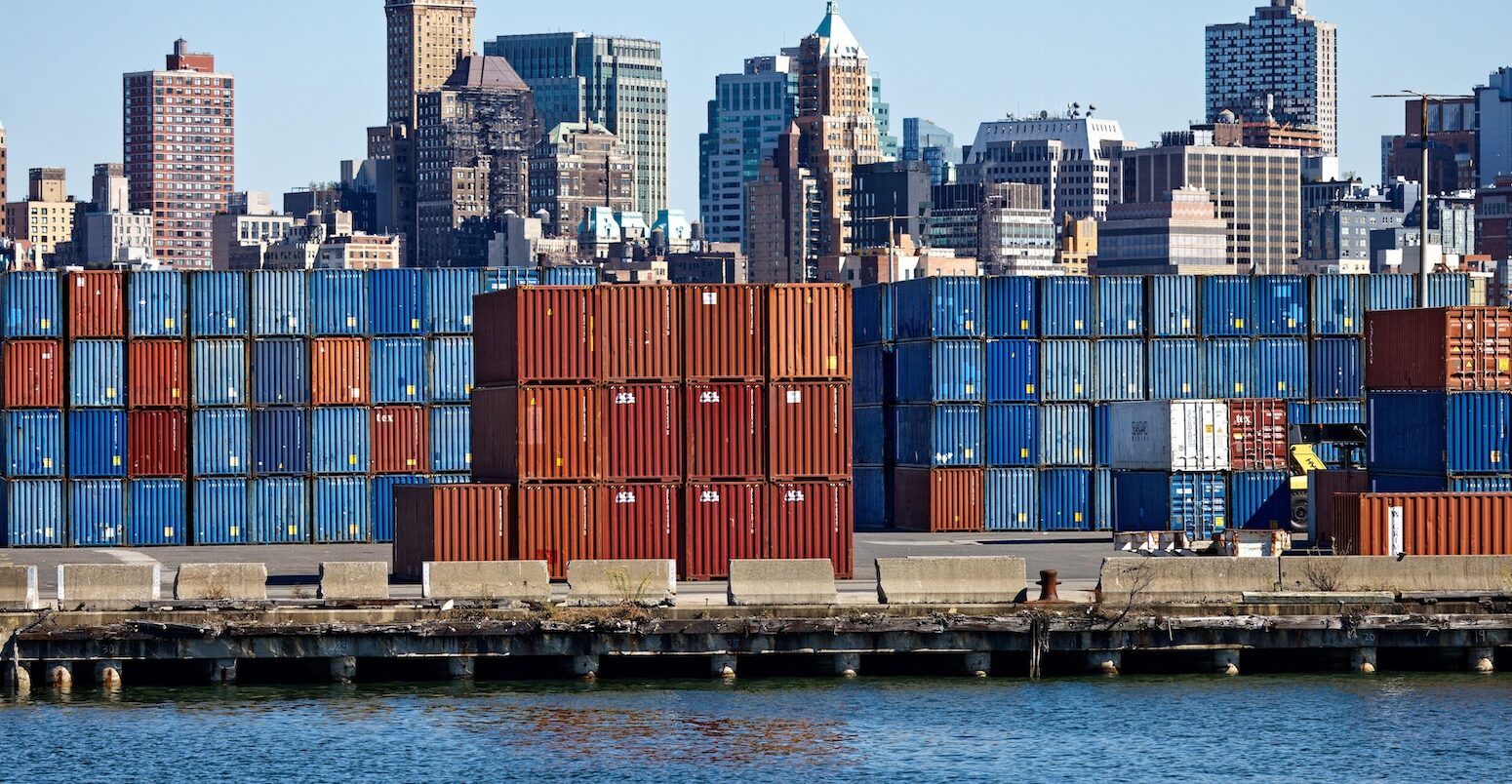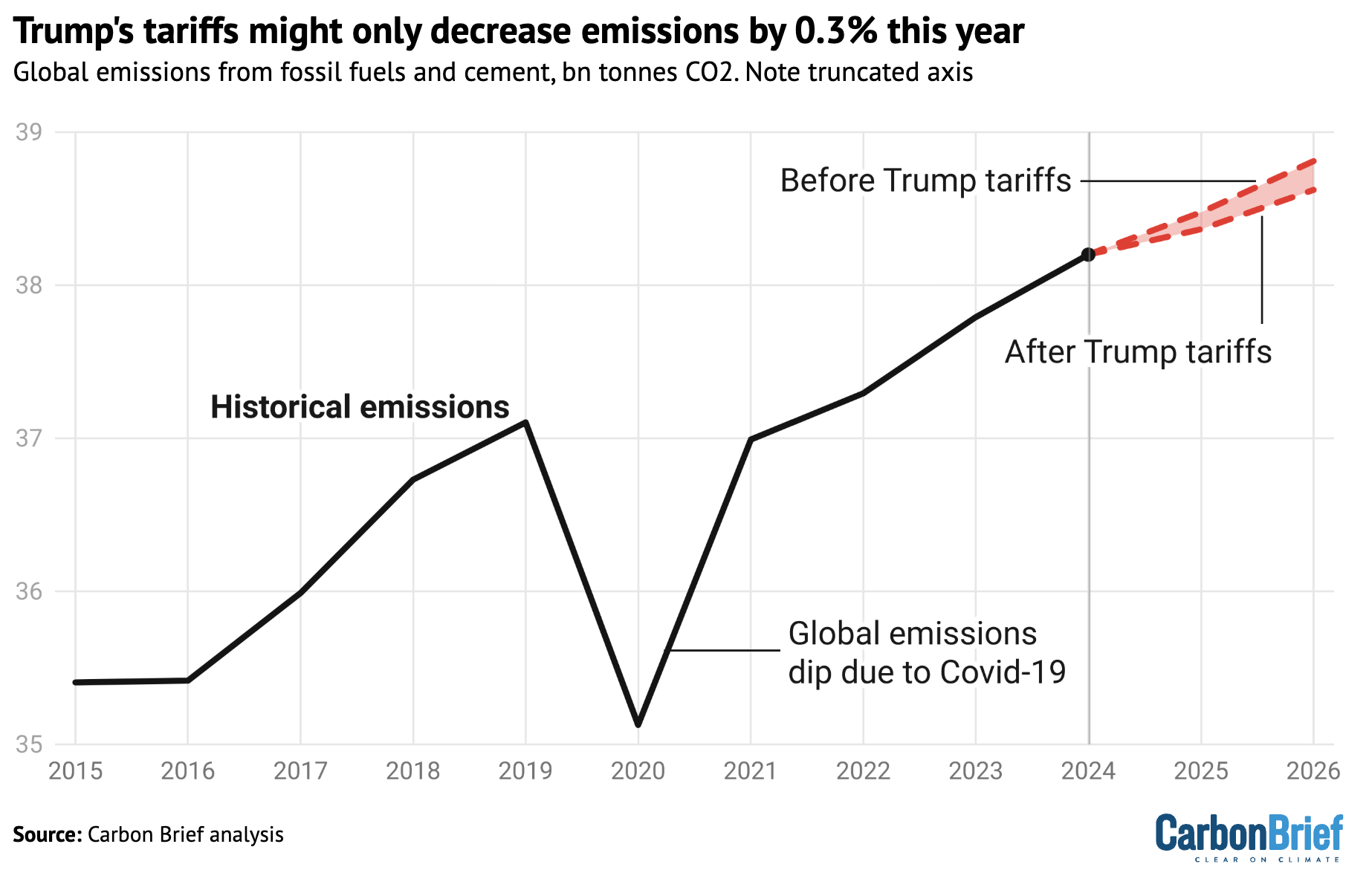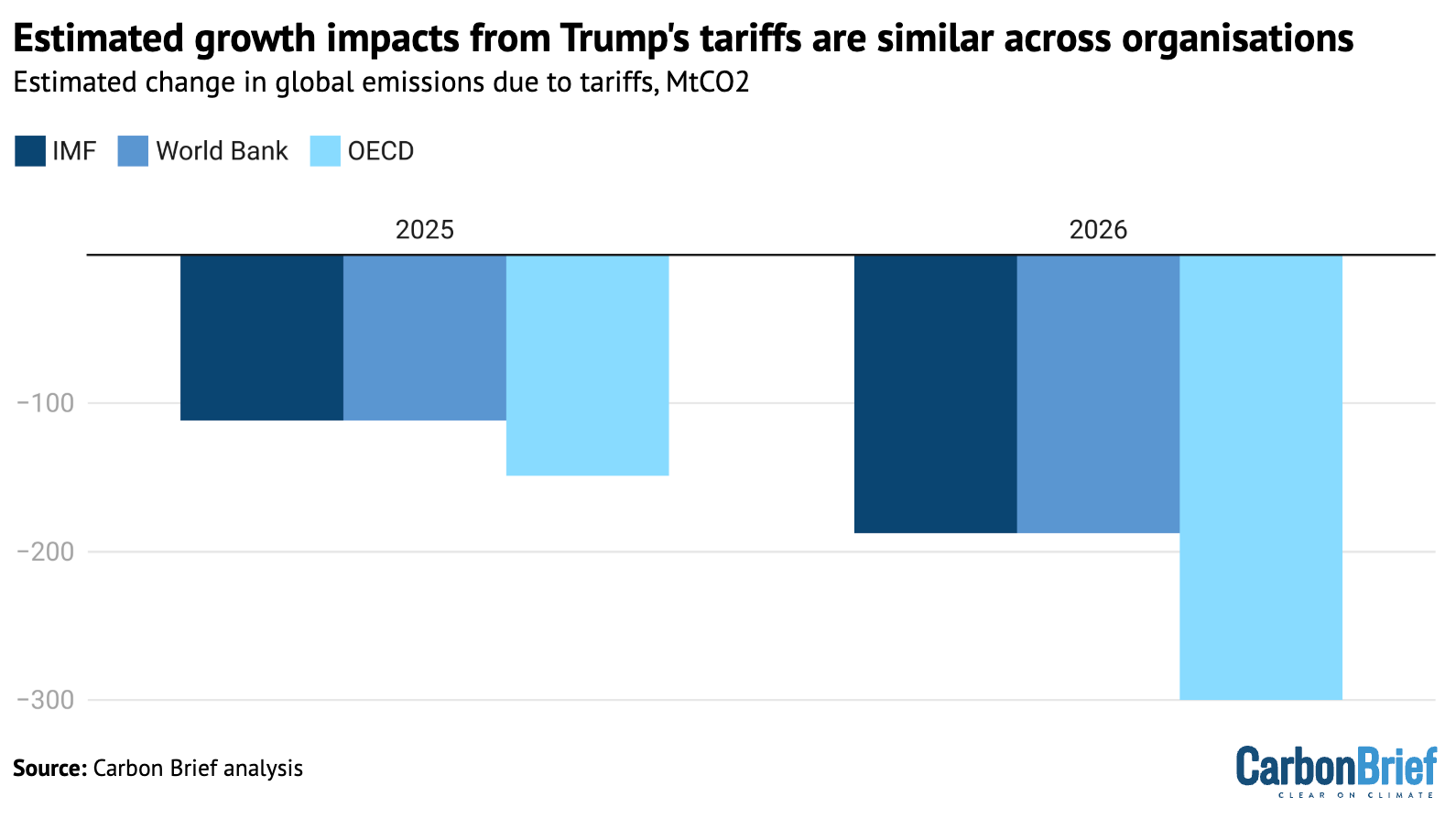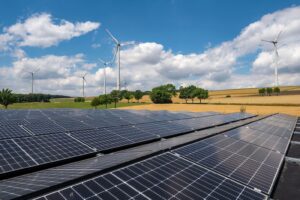
Analysis: Trump’s tariffs could cut just 0.3% from global CO2 emissions in 2025
Multiple Authors
07.30.25Multiple Authors
30.07.2025 | 4:51pmUS president Donald Trump’s tariffs might only shave 0.3% off global carbon dioxide (CO2) emissions this year, according to Carbon Brief analysis.
While the Trump administration is setting back international climate action through policies such as the “one big beautiful bill”, some analysts have argued that his tariffs would inadvertently cut carbon by throwing sand into the engine of the global economy.
However, Carbon Brief’s analysis, based on changing projections of economic growth since the tariffs were announced, shows that this effect is likely to be very limited.
The slew of new tariffs – initially announced on 2 April, dubbed by the president as “liberation day” – might only knock 110-150m tonnes of CO2 (MtCO2) off global emissions in 2025 (0.3-0.4%), the analysis shows.
For 2026, the tariffs could have a slightly higher impact, but still only 190-300MtCO2 (0.5-0.8%).

Trump’s “liberation day” tariffs included a 10% universal levy on all imported goods, alongside additional “reciprocal tariffs” on a number of countries he claimed had “cheated” the US.
The announcement sent the world’s stock markets into “turmoil”. The move has hit a range of diverse industries, including steel and aluminium, oil and more.
Despite initially saying he had no plans to pause the tariffs, Trump announced on 10 April that he would pause them for 90 days.
This pause was set to come to an end on 9 July, but, just days before this, he announced a further extension to 1 August. On his social-media network, Truth Social, Trump said countries would receive “letters and/or deals” on tariffs in the interim.
More recently, he has signed tariff deals with the European Union and countries such as the UK, Japan, the Philippines and others.
These deals reduce the headline tariff rates relative to the “liberation day” situation, as well as typically including a range of carve-outs and exemptions.
However, they do not end uncertainty over tariff levels and still leave US import levies at their highest levels “since the 1930s”, reducing expectations for trade and growth.
Since returning to office at the beginning of 2025, Trump – a climate sceptic – has rolled back a large number of environmental policies and protections.
Most recently, his “one big beautiful bill” was passed on 4 July, bringing an end to a number of former president Joe Biden’s policies, such as the Inflation Reduction Act (IRA), which provided support for electric vehicles, clean-technology manufacturing and more.
In combination with other Trump administration policies, this means the US will breach its now-defunct emissions reduction for 2030 target by a cumulative total of 7bn tonnes of CO2, previous Carbon Brief analysis found.
Nevertheless, numerous people suggested that the economic damage from Trump’s tariffs could “unintentionally” lead to a drop in carbon emissions.
For example, an April 2025 article in the New York Times stated: “Trump’s economic approach may inadvertently reduce greenhouse gas emissions, as consumption slows in response to a global trade war.”
The piece noted that the “reprieve for the planet” was likely to be short-lived, with longer-term impacts potentially hitting clean-energy deployment as international supply chains are hampered.
Similarly, an April 2025 Associated Press article quoted Global Carbon Project head Prof Rob Jackson saying that tariffs “might help the climate in the first year or two”. However, it quoted him continuing that this would come at a high cost and might backfire:
“I would say it might help the climate in the first year or two if we have a downturn in economic activity or a recession, which no one wants. But it will hurt the climate long-term because tariffs impact clean tech more than most other industries because of trade with China.”
Carbon Brief’s analysis shows that the emissions impact, even in the short term, is expected to be minimal.
It assessed the expected emissions impact of reduced global GDP by looking at changes to GDP forecasts from the International Monetary Fund (IMF), Organisation for Economic Cooperation and Development (OECD) and the World Bank, before and after Trump’s tariffs announcements.
The OECD suggests the biggest impact from the tariffs, as shown in the chart below.

The medium- to long-term impact of Trump’s trade wars is expected to be negative for climate action. In a recent interview, UK climate envoy Rachel Kyte told Carbon Brief that it created uncertainty and was likely to slow down clean-energy investment. She said:
“Investment flows when everybody feels confident, right?…[I]f I don’t know if the tariff is 10%, 20%, 25%, 56%, whatever, well, let me put it off till the next quarter to make that investment decision.”
Kyte added: “It’s the hesitancy that it puts in the mind of government, but also in the mind of investors and the private sector…[T]he sort of tariff era we’re in, the risk is that it slows down the investment in the clean-energy transition at a time when it needs to speed up.”
Methodology
Carbon Brief estimated the impact of Trump’s tariffs on global GDP by comparing growth forecasts published during June and July 2025 by the IMF World Economic Outlook, OECD Economic Outlook and World Bank Global Economic Prospects against corresponding forecasts published in December 2024 or January 2025, before Trump’s tariff announcements.
While Trump’s tariffs are not the only factor to have changed in these forecasts over the time period in question, they do represent a singular and sudden effect, which would be expected to have a significant impact on the global economic outlook.
The analysis estimates global GDP over 2025/2026 by applying the growth forecasts to historical GDP from the World Bank.
The reductions in forecast global GDP growth are translated into estimated emissions impacts by assuming that the “carbon intensity” of the world’s economy continues to improve at a steady rate, with or without the tariffs. Carbon intensity is the emissions per unit of GDP and has been improving slowly and steadily over many years.
The analysis only considers CO2 emissions from fossil fuels and cement production. Historical CO2 emissions data is taken from the Global Carbon Budget.
The range of estimated CO2 impacts stems from the varying GDP forecasts of the three different organisations.
For comparison, the International Energy Agency (IEA) has revised down its forecasts for global oil demand growth in 2025 by some 350,000 barrels of oil per day since the start of the year. This is equivalent to cutting global emissions this year by 40MtCO2.
The IEA’s forecasts for global coal demand in 2025 are broadly unchanged since the start of the year, with demand expected to grow 0.2% this year.
Words by Molly Lempriere. Analysis by Ho Woo Nam.





